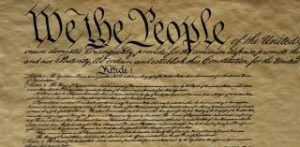
At the time of writing the dust has still not cleared a mob of pro-Trump supporters storming the Capitol Building. As the world looked on in disbelief, a motley crew of enraged loyalists to the outgoing President surged forwards and, quite literally, ran riot. Many were wearing combat gear, with or without “Make America Great Again” baseball caps, but others had more unusual costumes. The self-styled, spear wielding “Qanon Shaman” featured prominently in the news coverage, sporting horns, a fur cap, face-paint, leather trousers and no shirt. The ensemble presented himself as a weird mash-up of Wagner, Brave-Heart and the Village People.
It would all have been comical had the context not been so dark and serious. At best, Donald Trump’s speech to his assembled faithful prior to the invasion was petulant and self-indulgent, with no thought to the potential for injury and loss of life if violence sparked off. At worse, it was a calculated attempt to use violence and intimidation to interfere with the democratic process. Yet in a week when people around the globe have been glued to their screens wondering in horror how the United States came to this point, some of the strengths as well as the weaknesses of American Constitutional Culture have been demonstrated.
First, and perhaps most fundamentally, when it came to the crunch, senior Republic figures did not back the proto-coup which Trump launched. Influential players like Mitch McConnell and Mike Pence distanced themselves from the President and his action. There was a clear and overwhelming sentiment from Democrats and Republicans alike that Trump’s refusal to concede was now untenable, and his attempts at active resistance bordered on sedition. The prospect of a full frontal assault, or even a stealth attack, on the constitutional framework was met with horror.
Second, many of the rioters were themselves, however misguidedly, using the Constitution as a rallying cry. This is not remarkable at one level, given that calls to return to a golden past, or reinstating “true” versions of inherited values and identities, have been a feature of coups and revolutions from antiquity into the present day. The fact, however, was, undoubtedly, that the Constitution itself has talismanic status, and is worth fighting for (literally and metaphorically). In the US context, the Constitution is not simply a set of political and legal norms, it is an integral part of national self-understanding. To put it differently, loyalty to the Constitution is equated with patriotism, the document is what made and continues to make America.
Against this backdrop, it is of course inevitable that fringe and extremist movements will attempt to hijack it from time to time in a bid for legitimacy (see our previous blog, linked below, on the Magna Carta and Freemen on the Land). However, the strength of investment which mainstream society, across the political spectrum, has in the US Constitution, means that Alt Right conspiracy theorists have no hope of claiming it for their own. A group can use a symbol if they so choose, but whilst millions of people outside of the group use the exact same symbol, it will never be their exclusive property. A society which respects freedom of expression cannot prohibit the Far Right from wearing the US flag, or for that matter tattooing Viking symbols all over their body, but this doesn’t mean that such movements can hope to own either the Stars and Stripes or the Norse Culture.
One positive dimension in this is that a shared icon in the Constitution holds out the hope of growth and change for individuals who have been sucked into extremist politics. No doubt some of the people rioting in Washington will cling to eccentric, intolerant, and in many cases, downright hateful views for the rest of their time on earth. However, this does not have to be true of all of them. Given that they live in a society in which the Constitution is a high-profile topic of discussion and debate, they may be exposed to intellectual breadcrumbs which lead them to explore different paths and ideas. A passion for the Constitution opens the doors to conversations about what the text truly means, and how best to defend it.
Well over three centuries on, the words in the Preamble to the Constitution remain inspiring:
“We the People of the United States, in Order to form a more perfect Union, establish Justice, ensure domestic Tranquillity, provide for the common defence, promote the general Welfare, and secure the Blessings of Liberty to ourselves and our Posterity, do ordain and establish this Constitution for the United States of America.”
Despite all the references to the Constitution which we heard last week, it is very difficult to align any of those aims with smashing into Government buildings and attempting to overturn the democratic process. Let us hope that these positive aspirations continue leading the United States of America, such an important partner and friend for those of us in Europe.
Related Articles
Qanon Shaman Jake Angeli charged over pro-Trump riot BBC News (9/1/21)
Maga Mob’s Captiol Invasion makes Trump’s assault on democracy literal The Guardian (7/1/21)
Magna Carta, Myths and Freemen on the Land Balancing Beliefs (23/12/20)
Norse Symbols: Their Unknowable Meanings Jackson Crawford (2/9/20)


